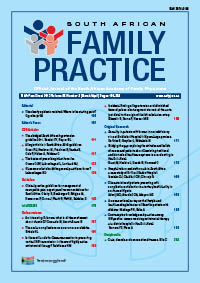Bridging the gap: exploring the attitudes and beliefs of nurses and patients about coexisting traditional and biomedical healthcare systems in a rural setting in KwaZulu-Natal
Keywords:
Health worker, traditional healthcare, biomedical healthcare, culture
Abstract
Objectives: Health care in South Africa takes place within a diverse cultural context and includes perceptions about health that strongly link to cultural beliefs and values. Biomedical healthcare professionals, particularly nurses, are exposed to and expected to cope with cultural challenges on a daily basis, with little or no training on how to do so. In this paper, we explore nurse and patient attitudes to and beliefs about how the systems of health care coexist, what issues this raises and how nurses and patients address these issues in their daily practice. Design: The study employed an exploratory, qualitative research design. Setting and subjects: Four in-depth focus group discussions were conducted with nurses and patients at a deep rural, district hospital in northern KwaZulu-Natal. Participants were selected based on their availability and willingness to contribute to the discussion. Results: Traditional and biomedical healthcare systems coexist and are used simultaneously with the healthcare- seeking pattern of patients traversing multiple systems of care. Currently, patients and nurses have developed strategies to address this by steering a pragmatic course to minimise risks, and by doing so, bridging the gap between the two healthcare mediums. Conclusion: Further research is required to understand which illnesses are primarily seen as traditional, how this gap can be effectively addressed, and how different healthcare co-delivery models can best be utilised and evaluated.
Published
2012-09-06
Section
Original Research
By submitting manuscripts to SAFP, authors of original articles are assigning copyright to the South African Academy of Family Physicians. Copyright of review articles are assigned to the Publisher, Medpharm Publications (Pty) Ltd, unless otherwise specified. Authors may use their own work after publication without written permission, provided they acknowledge the original source. Individuals and academic institutions may freely copy and distribute articles published in SAFP for educational and research purposes without obtaining permission.

